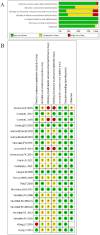The Choice of Hip Arthroplasty: HRA or THA? Revealed by Meta-Analysis
- PMID: 40090766
- PMCID: PMC12146122
- DOI: 10.1111/os.70019
The Choice of Hip Arthroplasty: HRA or THA? Revealed by Meta-Analysis
Abstract
Background: Total hip arthroplasty (THA) is the gold standard for end-stage hip arthrosis, while hip resurfacing arthroplasty (HRA) is considered a more bone-conserving alternative. This meta-analysis aimed to compare the safety and clinical efficacy of HRA and THA.
Methods: The databases of PubMed, EMBASE, Cochrane Library, and CNKI were searched for RCTs comparing HRA and THA in treating hip arthrosis from database initiation to April 2024. Inclusion and exclusion criteria were defined, and data extraction, quality evaluation, and risk bias assessment were performed. A meta-analysis was conducted using appropriate RevManv5.4 and Stata v14.0 software.
Results: Twenty RCTs from six countries were included. HRA had a similar revision rate, function scores (WOMAC, HSS, OHS, UCLA activity score, EQ-D, EQ-5D VAS), and blood levels of cobalt and chromium compared to THA. HRA had fewer complications and less blood loss but required more operating time.
Conclusions: HRA is a safe and effective alternative to THA, with similar revision and functional outcomes, less blood loss, and is particularly suitable for young male patients with a demand for high-level activities.
Keywords: clinical efficacy; hip arthrosis; hip resurfacing arthroplasty (HRA); meta‐analysis; safety; systematic review; total hip arthroplasty (THA).
© 2025 The Author(s). Orthopaedic Surgery published by Tianjin Hospital and John Wiley & Sons Australia, Ltd.
Conflict of interest statement
The authors declare no conflicts of interest.
Figures
















References
-
- Rueckl K., Liebich A., Bechler U., Springer B., Rudert M., and Boettner F., “Return to Sports After Hip Resurfacing Versus Total Hip Arthroplasty: A Mid‐Term Case Control Study,” Archives of Orthopaedic and Trauma Surgery 140, no. 7 (2020): 957–962. - PubMed
Publication types
MeSH terms
Grants and funding
LinkOut - more resources
Full Text Sources
Medical
Miscellaneous

